Fuel injection
Fuel injection is the introduction of fuel in an internal combustion engine, most commonly automotive engines, by the means of an injector. This article focuses on fuel injection in reciprocating piston and Wankel rotary engines.

All compression-ignition engines (e.g. diesel engines), and many spark-ignition engines (i.e. petrol engines, such as Otto or Wankel), use fuel injection of one kind or another. Mass-produced diesel engines for passenger cars (such as the Mercedes-Benz OM 138) became available in the late 1930s and early 1940s, being the first fuel injected engines for passenger car use.[1] In passenger car petrol engines, fuel injection was introduced in the early 1950s and gradually gained prevalence until it had largely replaced carburettors by the early 1990s.[2] The primary difference between carburetion and fuel injection is that fuel injection atomizes the fuel through a small nozzle under high pressure, while a carburettor relies on suction created by intake air accelerated through a Venturi tube to draw fuel into the airstream.
The term "fuel injection" is vague and comprises various distinct systems with fundamentally different functional principles. Typically, the only thing in common all fuel injection systems have is a lack of carburetion. There are two main functional principles of mixture formation systems for internal combustion engines: internal mixture formation, and external mixture formation. A fuel injection system that uses external mixture formation is called a manifold injection system. There exist two types of manifold injection systems: multi-point injection (or port injection) and single-point injection (or throttle body injection). Internal mixture formation systems can be separated into direct and indirect injection systems. There exist several different varieties of both direct and indirect injection systems; the most common internal mixture formation fuel injection system is the common-rail injection system, a direct injection system. The term "electronic fuel injection" refers to any fuel injection system controlled by an engine control unit.
Fundamental considerations
An ideal fuel injection system can precisely provide exactly the right amount of fuel under all engine operating conditions. This typically means precise air–fuel ratio (lambda) control, which allows, for instance: easy engine operation even at low engine temperatures (such as a cold start), good adaptation to a wide range of altitudes and ambient temperatures, precisely governed engine speeds (including at idle and redline), good fuel efficiency, and the lowest achievable exhaust emissions (which allows emissions control devices, such as a three-way catalytic converter, to function properly).
In practice, an ideal fuel injection system does not exist, but there is a huge variety of different fuel injection systems with certain advantages and disadvantages. Most of these systems were rendered obsolete by the common-rail direct injection system that is, as of 2020, used in many passenger cars. Common-rail injection allows for petrol direct injection, and is even better suited for diesel direct injection. However, common-rail injection is a relatively complex system, which is why in some passenger cars that do not use diesel engines, a multi-point manifold injection system is used instead.
When designing a fuel injection system, a variety of factors has to be taken into consideration, including:
- System cost
- Engine performance and vehicle driveability (ease of starting, smooth running, etc.)
- Exhaust emissions
- Diagnostic provisions and ease of service
- Fuel efficiency
- Reliability
- Ability to run on various fuels
System components
All fuel injection systems comprise three basic components: they have at least one fuel injector (sometimes called an injection valve), a device that creates sufficient injection pressure, and a device that meters the correct amount of fuel. These three basic components can either be separate devices (one or multiple fuel injectors, a fuel distributor, and a fuel pump), partially combined devices (an injection valve and an injection pump), or completely combined devices (a unit injector).
Early mechanical injection systems (except for air-blast injection) typically used injection valves with needle-like nozzles in combination with one or multiple relatively sophisticated helix-controlled injection pumps that both metered fuel and created injection pressure. They were well-suited for intermittent multi-point injection systems as well as all sorts of conventional direct injection and chamber injection systems.
Advancements in the field of microelectronics allowed injection system manufacturers to significantly improve the accuracy of the fuel metering device. In modern engines, fuel metering and injection valve actuation is usually done by the engine control unit. Therefore, the fuel injection pump does not have to meter the fuel or actuate the injection valves; it only needs to provide injection pressure. These modern systems are used in multi-point-injected engines and common-rail-injected engines. Unit injection systems have made it into series production in the past, but proved to be inferior to common-rail injection.
Classification
Summary
The overview below illustrates the most common types of mixture formation systems in internal combustion engines. There are several different ways of characterising, grouping, and describing fuel injection systems. The classifications are based upon differentiation between internal and external mixture formation systems.
Overview
- Mixture formation systems
- Internal mixture formation
- External mixture formation
External mixture formation
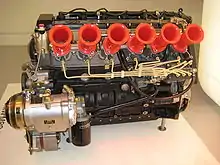
In an engine with external mixture formation, air and fuel are mixed outside the combustion chamber so that a mixture of air and fuel is sucked into the engine. External mixture formation systems are common in petrol-fuelled engines such as the Otto engine and the Wankel engine. There exist two main external mixture formation systems in internal combustion engines: carburettors and manifold injection. The following description focuses on the latter.
Manifold injection systems can also be considered indirect injection, but this article primarily uses the term indirect injection to describe internal mixture formation systems that are not direct injection. There exist two types of manifold injection: single-point injection, and multi-point injection.[13] They can use several different injection schemes.
Single-point injection
Single-point injection uses one injector in a throttle body mounted similarly to a carburettor on an intake manifold. As in a carburetted induction system, the fuel is mixed with the air before entering the intake manifold.[13] Single-point injection was a relatively low-cost way for automakers to reduce exhaust emissions to comply with tightening regulations while providing better "driveability" (easy starting, smooth running, no engine stuttering) than could be obtained with a carburettor. Many of the carburettor's supporting components—such as the air filter, intake manifold, and fuel line routing—could be used with few or no changes. This postponed the redesign and tooling costs of these components. Single-point injection was used extensively on American-made passenger cars and light trucks during 1980–1995, and in some European cars in the early and mid-1990s.
Multi-point injection
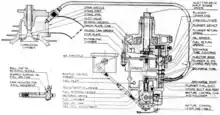
Multi-point injection injects fuel into the intake ports just upstream of each cylinder's intake valve, rather than at a central point within an intake manifold. Typically, multi-point injected systems use multiple fuel injectors,[13] but some systems, such as GM's central port injection system, use tubes with poppet valves fed by a central injector instead of multiple injectors.[15]
Injection schemes
Manifold-injected engines can use several injection schemes: continuous, and intermittent (simultaneous, batched, sequential, and cylinder-individual).
In a continuous injection system, fuel flows at all times from the fuel injectors, but at a variable flow rate. The most common automotive continuous injection system is the Bosch K-Jetronic system, introduced in 1974 and used until the mid-1990s by various car manufacturers. Intermittent injection systems can be sequential, in which injection is timed to coincide with each cylinder's intake stroke; batched, in which fuel is injected to the cylinders in groups, without precise synchronization to any particular cylinder's intake stroke; simultaneous, in which fuel is injected at the same time to all the cylinders; or cylinder-individual, in which the engine control unit can adjust the injection for each cylinder individually.[14]
Internal mixture formation
In an engine with an internal mixture formation system, air and fuel are mixed only inside the combustion chamber. Therefore, only air is sucked into the engine during the intake stroke. The injection scheme is always intermittent (either sequential or cylinder-individual). There are two different types of internal mixture formation systems: indirect injection, and direct injection.
Indirect injection
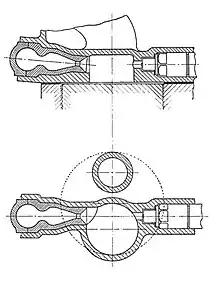
This article describes indirect injection as an internal mixture formation system (typical of Akroyd (hot-bulb) and Diesel engines); for external mixture formation systems that are sometimes called indirect injection (typical of Otto and Wankel engines), this article uses the term manifold injection.
In an indirect-injected engine, there are two combustion chambers: a main combustion chamber, and a pre-chamber (also called an ante-chamber)[16] that is connected to the main one. The fuel is injected only into the pre-chamber (where it begins to combust), and not directly into the main combustion chamber. Therefore, this principle is called indirect injection. There exist several slightly different indirect injection systems that have similar characteristics.[3] All Akroyd engines and some Diesel engines use indirect injection.
Direct injection
Direct injection means that an engine only has a single combustion chamber and that the fuel is injected directly into this chamber.[17] This can be done either with a blast of air (air-blast injection) or hydraulically. The latter method is far more common in automotive engines. Typically, hydraulic direct injection systems spray fuel into the air inside the cylinder or combustion chamber, but some systems spray the fuel against the combustion chamber walls (as in the M-System). Hydraulic direct injection can be achieved with a conventional helix-controlled injection pump, unit injectors, or a sophisticated common-rail injection system. The latter is the most common system in modern automotive engines. Direct injection is well-suited for a huge variety of fuels, including petrol and diesel fuel.
In a common rail system, fuel from the fuel tank is supplied to a common header (called the accumulator), and then sent through tubing to the injectors, which inject it into the combustion chamber. The accumulator has a high-pressure relief valve to maintain pressure and return the excess fuel to the fuel tank. The fuel is sprayed with the help of a nozzle that is opened and closed with a solenoid-operated needle valve.[18] Third-generation common rail diesels use piezoelectric injectors for increased precision, with fuel pressures up to 300 MPa or 44,000 lbf/in2.[19]
History and development
1870s – 1920s: early systems
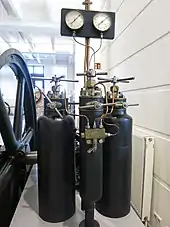
In 1872, George Bailey Brayton obtained a patent on an internal combustion engine that used a pneumatic fuel injection system, also invented by Brayton: air-blast injection.[20] In 1894, Rudolf Diesel copied Brayton's air-blast injection system for the diesel engine, but also improved it.[21] He increased the air blast pressure from 4–5 kp/cm2 (390–490 kPa) to 65 kp/cm2 (6,400 kPa).[22]
The first manifold injection system was designed by Johannes Spiel at Hallesche Maschinenfabrik in 1884.[23] In the early 1890s, Herbert Akroyd Stuart developed an indirect fuel injection system[24] using a 'jerk pump' to meter out fuel oil at high pressure to an injector. This system was used on the Akroyd engine and was adapted and improved by Bosch and Clessie Cummins for use on diesel engines.

In 1898, Deutz AG started series production of stationary four-stroke Otto engines with manifold injection. Eight years later, Grade equipped their two-stroke engines with manifold injection, and both Léon Levavasseur's Antoinette 8V (the world's first ever V8 engine, patented by Levavasseur in 1902), and Wright aircraft engines were fitted with manifold injection as well. The first engine with petrol direct injection was a two-stroke aircraft engine designed by Otto Mader in 1916.[25]
Another early use of petrol direct injection was on the Hesselman engine, invented by Swedish engineer Jonas Hesselman in 1925.[26][27] Hesselman engines use the stratified charge principle; fuel is injected towards the end of the compression stroke, then ignited with a spark plug. They can run on a large variety of fuels.[28]
The invention of the pre-combustion chamber injection by Prosper l'Orange helped diesel engine manufacturers to overcome the problems of air-blast injection, and allowed for the designing of small automotive engines from the 1920s onwards. In 1924, MAN presented the first direct-injected diesel engine for lorries.[4]
1930s – 1950s: first mass-produced petrol direct injection
In 1936, Daimler-Benz began mass production of the precombustion chamber-injected Mercedes-Benz OM 138 diesel engine, one of the first passenger car engines with fuel injection.[29] During World War II, direct petrol injection was used in notable aero engines such as the Junkers Jumo 210, the Daimler-Benz DB 601, the BMW 801, and the Shvetsov ASh-82FN (M-82FN). German direct-injection petrol engines used injection systems developed by Bosch, Deckel, Junkers and l'Orange from their diesel injection systems.[30] Later versions of the Rolls-Royce Merlin and Wright R-3350 used single-point injection, at the time called a "Pressure Carburettor". Due to the wartime relationship between Germany and Japan, Mitsubishi also had two radial aircraft engines using petrol direct injection, the Mitsubishi Kinsei and Mitsubishi Kasei. In addition, the Nakajima Homare Model 23 used a low-pressure fuel injection system.[31]
The first automotive direct injection system used to run on petrol was developed by Bosch and introduced by Goliath for their GP700 and Gutbrod for their Superior in 1952. This was essentially a specially lubricated high-pressure diesel direct-injection pump of the type that is governed by the vacuum behind an intake throttle valve.[32] The 1954 Mercedes-Benz W196 Formula One racing car engine used Bosch direct injection derived from wartime aircraft engines. Following the W196's success on the track, the 1955 Mercedes-Benz 300SL became the first passenger car with a four-stroke direct injection Otto engine.[33] Later, more mainstream applications of fuel injection favored the less-expensive manifold injection design.
1950s – 1980s: series production manifold injection systems

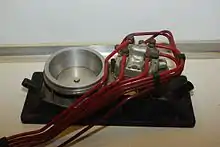
Throughout the 1950s, several manufacturers introduced their manifold injection systems for Otto engines, including General Motors' Rochester Products Division, Bosch, and Lucas Industries.[34] During the 1960s, additional manifold injection systems such as the Hilborn,[35] Kugelfischer, and SPICA systems were introduced.
The first commercial electronically controlled manifold injection system was the Electrojector developed by Bendix and was offered by American Motors Corporation (AMC) in 1957.[36][37] Initial problems with the Electrojector meant only pre-production cars had it installed so very few cars were sold[38] and none were made available to the public.[39] The EFI system in the Rambler worked well in warm weather, but was difficult to start in cooler temperatures.[40]
Chrysler offered Electrojector on the 1958 Chrysler 300D, DeSoto Adventurer, Dodge D-500, and Plymouth Fury, arguably the first series-production cars equipped with an EFI system.[41] The Electrojector patents were subsequently sold to Bosch, who developed the Electrojector into the Bosch D-Jetronic. The D in D-Jetronic stands for Druckfühlergesteuert, German for "pressure-sensor controlled"). The D-Jetronic was first used on the VW 1600TL/E in 1967. This was a speed/density system, using engine speed and intake manifold air density to calculate "air mass" flow rate and thus fuel requirements.
Bosch superseded the D-Jetronic system with the K-Jetronic and L-Jetronic multi-point injection systems for 1973, though some cars (such as the Volvo 164) continued using D-Jetronic for the following several years. The L-Jetronic uses a mechanical airflow meter (L for Luft, German for "air") that produces a signal that is proportional to volume flow rate. This approach required additional sensors to measure the atmospheric pressure and temperature, to calculate mass flow rate with an analogue ECU. L-Jetronic was widely adopted on European cars of that period, and a few Japanese models a short time later. The K-Jetronic (K for Kontinuierlich, German for "continuous") is a fully mechanical system that injects the fuel in a continuous spray with a variable flow rate. It does not have an ECU, instead, it relies on the intake manifold vacuum to actuate its fuel distributor's plunger.[42] The first car equipped with this system was the American 1973 Porsche 911T (F-series).[43]
1979 – 1990s
The first digital engine management system (engine control unit) was the Bosch Motronic introduced in 1979. In 1980, Motorola (now NXP Semiconductors) introduced their digital ECU EEC-III.[44] The EEC-III is a single-point injection system.[45]
Manifold injection was phased in through the latter 1970s and 80s at an accelerating rate, with the German, French, and U.S. markets leading and the UK and Commonwealth markets lagging somewhat. Since the early 1990s, almost all petrol passenger cars sold in first world markets are equipped with electronic manifold injection. The carburettor remains in use in developing countries where vehicle emissions are unregulated and diagnostic and repair infrastructure is sparse. Fuel injection systems are gradually replacing carburettors in these nations too as they adopt emission regulations conceptually similar to those in force in Europe, Japan, Australia, and North America.
Since 1990
In 1995, Mitsubishi presented the first common-rail petrol direct injection system for passenger cars. It was introduced in 1997.[46] Subsequently, common-rail direct injection was also introduced in passenger car diesel engines, with the Fiat 1.9 JTD being the first mass market engine.[47] In the early 2000s, several car manufacturers attempted to use stratified charge concepts in their direct injection petrol engines to reduce fuel consumption. However, the fuel savings proved to be almost unnoticeable and disproportionate to the increased complexity of the exhaust gas treatment systems. Therefore, almost all car manufacturers have switched to a conventional homogeneous mixture in their direct injected petrol engines since the mid-2010s. In the early 2020s, some car manufacturers have still been using manifold injection, especially in economy cars, but also some high performance cars. Ever since 1997, car manufacturers have been using common-rail direct injection for their diesel engines. Only Volkswagen used the Pumpe-Düse system throughout the early 2000s, but they have also been using common-rail direct injection since 2010.
Notes
- Kremser, H. (1942). Der Aufbau schnellaufender Verbrennungskraftmaschinen für Kraftfahrzeuge und Triebwagen (in German). Vol. 11. Vienna: Springer. p. 125. ISBN 9783709150160.
- Welshans, Terry (August 2013). "A Brief History of Aircraft Carburetors and Fuel Systems". enginehistory.org. US: Aircraft Engine Historical Society. Retrieved 28 June 2016.
- Olaf von Fersen (ed.): Ein Jahrhundert Automobiltechnik. Personenwagen, VDI-Verlag, Düsseldorf 1986, ISBN 978-3-642-95773-4. p. 273
- von Fersen (ed.), p. 130
- Sass, Friedrich (1962). Geschichte des deutschen Verbrennungsmotorenbaues von 1860 bis 1918 (in German). Berlin: Springer. p. 417. ISBN 9783662118436.
- Rüdiger Teichmann, Günter P. Merker (publisher)
- Hellmut Droscha (ed.): Leistung und Weg – Zur Geschichte des MAN-Nutzfahrzeugbaus, Springer, Berlin/Heidelberg 1991, ISBN 978-3-642-93490-2. p. 433
- Helmut Tschöke, Klaus Mollenhauer, Rudolf Maier (ed.): Handbuch Dieselmotoren, 8th edition, Springer, Wiesbaden 2018, ISBN 978-3-658-07696-2, p. 295
- Richard van Basshuysen (ed.): Ottomotor mit Direkteinspritzung und Direkteinblasung: Ottokraftstoffe, Erdgas, Methan, Wasserstoff, 4th edition, Springer, Wiesbaden 2017, ISBN 978-3-658-12215-7, p. 62
- Helmut Hütten: Motoren. Technik, Praxis, Geschichte. Motorbuchverlag, Stuttgart 1982, ISBN 3-87943-326-7
- von Fersen, Olaf, ed. (1987). Ein Jahrhundert Automobiltechnik : Nutzfahrzeuge (in German). Berlin, Heidelberg: Springer. p. 131. ISBN 9783662011201.
- Hellmut Droscha (ed.): Leistung und Weg – Zur Geschichte des MAN-Nutzfahrzeugbaus, Springer, Berlin/Heidelberg 1991, ISBN 978-3-642-93490-2. p. 429
- Kurt Lohner, Herbert Müller (auth): Gemischbildung und Verbrennung im Ottomotor, in Hans List (ed.): Die Verbrennungskraftmaschine, Band 6, Springer, Wien 1967, ISBN 978-3-7091-8180-5, p. 64
- Konrad Reif (ed.): Ottomotor-Management, 4th edition, Springer, Wiesbaden 2014, ISBN 978-3-8348-1416-6, p. 107
- 1997 Chevrolet Truck Service Manual, page 6A-24, drawing, item (3) Central Sequential Muliport injector.
- Hawks, Ellison (1939). How it works and how it's done. London: Odhams Press. p. 75.
- "IC Engines". Global Fuel Economy Initiative. Archived from the original on 6 October 2012. Retrieved 1 May 2014.
- Helmut Tschöke, Klaus Mollenhauer, Rudolf Maier (ed.): Handbuch Dieselmotoren, 8th edition, Springer, Wiesbaden 2018, ISBN 978-3-658-07696-2, p. 289
- Helmut Tschöke, Klaus Mollenhauer, Rudolf Maier (ed.): Handbuch Dieselmotoren, 8th edition, Springer, Wiesbaden 2018, ISBN 978-3-658-07696-2, p. 1000
- Sass, p. 413
- Sass, p. 414
- Sass, p. 415
- Richard van Basshuysen (ed.): Ottomotor mit Direkteinspritzung und Direkteinblasung: Ottokraftstoffe, Erdgas, Methan, Wasserstoff, 4th edition, Springer, Wiesbaden 2017, ISBN 978-3-658-12215-7, p. 6
- Hall, Carl W. (2008). A Biographical Dictionary of People in Engineering: From Earliest Records to 2000 (1st ed.). Purdue University Press – via Credo Reference.
- Richard van Basshuysen (ed.): Ottomotor mit Direkteinspritzung und Direkteinblasung: Ottokraftstoffe, Erdgas, Methan, Wasserstoff, 4th edition, Springer, Wiesbaden 2017, ISBN 978-3-658-12215-7, p. 7
- Lindh, Björn-Eric (1992). Scania fordonshistoria 1891-1991 (in Swedish). Streiffert. ISBN 978-91-7886-074-6.
- Olsson, Christer (1990). Volvo – Lastbilarna igår och idag (in Swedish). Förlagshuset Norden. ISBN 978-91-86442-76-7.
- Richard van Basshuysen (ed.): Ottomotor mit Direkteinspritzung und Direkteinblasung: Ottokraftstoffe, Erdgas, Methan, Wasserstoff, 4th edition, Springer, Wiesbaden 2017, ISBN 978-3-658-12215-7, pp. 17–18
- Olaf von Fersen (ed.): Ein Jahrhundert Automobiltechnik. Personenwagen, VDI-Verlag, Düsseldorf 1986, ISBN 978-3-642-95773-4. p. 274
- Richard van Basshuysen (ed.): Ottomotor mit Direkteinspritzung und Direkteinblasung: Ottokraftstoffe, Erdgas, Methan, Wasserstoff, 4th edition, Springer, Wiesbaden 2017, ISBN 978-3-658-12215-7, p. 10
- Nakagawa, Ryoichi; Mizutani, Sotaro (1988). "Engine Fuels and Lubrication Systems at Nakajima Aircraft Co. from 1936 - 1945". Mobilus. SAE Technical Paper Series. US: Society of Automobile Engineers. 1. doi:10.4271/881610. eISSN 2688-3627. ISSN 0148-7191.
- Richard van Basshuysen (ed.): Ottomotor mit Direkteinspritzung und Direkteinblasung: Ottokraftstoffe, Erdgas, Methan, Wasserstoff, 4th edition, Springer, Wiesbaden 2017, ISBN 978-3-658-12215-7, p. 19
- Richard van Basshuysen (ed.): Ottomotor mit Direkteinspritzung und Direkteinblasung: Ottokraftstoffe, Erdgas, Methan, Wasserstoff, 4th edition, Springer, Wiesbaden 2017, ISBN 978-3-658-12215-7, p. 20
- "A short history of Lucas injection". lucasinjection.com. Retrieved 1 May 2015.
- Walton, Harry (March 1957). "How Good is Fuel Injection?". Popular Science. 170 (3): 88–93. Retrieved 1 May 2015.
- Ingraham, Joseph C. (24 March 1957). "Automobiles: Races; Everybody Manages to Win Something at the Daytona Beach Contests". The New York Times. p. 153. Retrieved 1 May 2015.
- "1957 cars". Consumer Reports. 22: 154. 1957.
- Aird, Forbes (2001). Bosch fuel injection systems. HP Trade. p. 29. ISBN 978-1-55788-365-0.
- Kendall, Leslie. "American Musclecars: Power to the People". Petersen Automotive Museum. Archived from the original on 27 October 2011. Retrieved 13 March 2022.
- Auto Editors of Consumer Guide (22 August 2007). "Rambler Measures Up". Archived from the original on 29 August 2020. Retrieved 13 March 2022.
{{cite web}}: CS1 maint: uses authors parameter (link) - "1958 DeSoto Electrojector - First electronic fuel injection?". allpar.com. Retrieved 8 November 2018.
- Olaf von Fersen (ed.): Ein Jahrhundert Automobiltechnik. Personenwagen, VDI-Verlag, Düsseldorf 1986, ISBN 978-3-642-95773-4. p. 256
- Olaf von Fersen (ed.): Ein Jahrhundert Automobiltechnik. Personenwagen, VDI-Verlag, Düsseldorf 1986, ISBN 978-3-642-95773-4. p. 260
- "A Timeline Overview of Motorola History 1928-2009" (PDF). Motorola. Archived from the original (PDF) on 20 June 2011. Retrieved 20 January 2014.
- Olaf von Fersen (ed.): Ein Jahrhundert Automobiltechnik. Personenwagen, VDI-Verlag, Düsseldorf 1986, ISBN 978-3-642-95773-4. p. 262
- Richard van Basshuysen (ed.): Ottomotor mit Direkteinspritzung und Direkteinblasung: Ottokraftstoffe, Erdgas, Methan, Wasserstoff, 4th edition, Springer, Wiesbaden 2017, ISBN 978-3-658-12215-7, p. 138
- Günter P. Merker, Rüdiger Teichmann (ed.): Grundlagen Verbrennungsmotoren – Funktionsweise · Simulation · Messtechnik, 7th edition, Springer, Wiesbaden 2014, ISBN 978-3-658-03194-7, p. 179